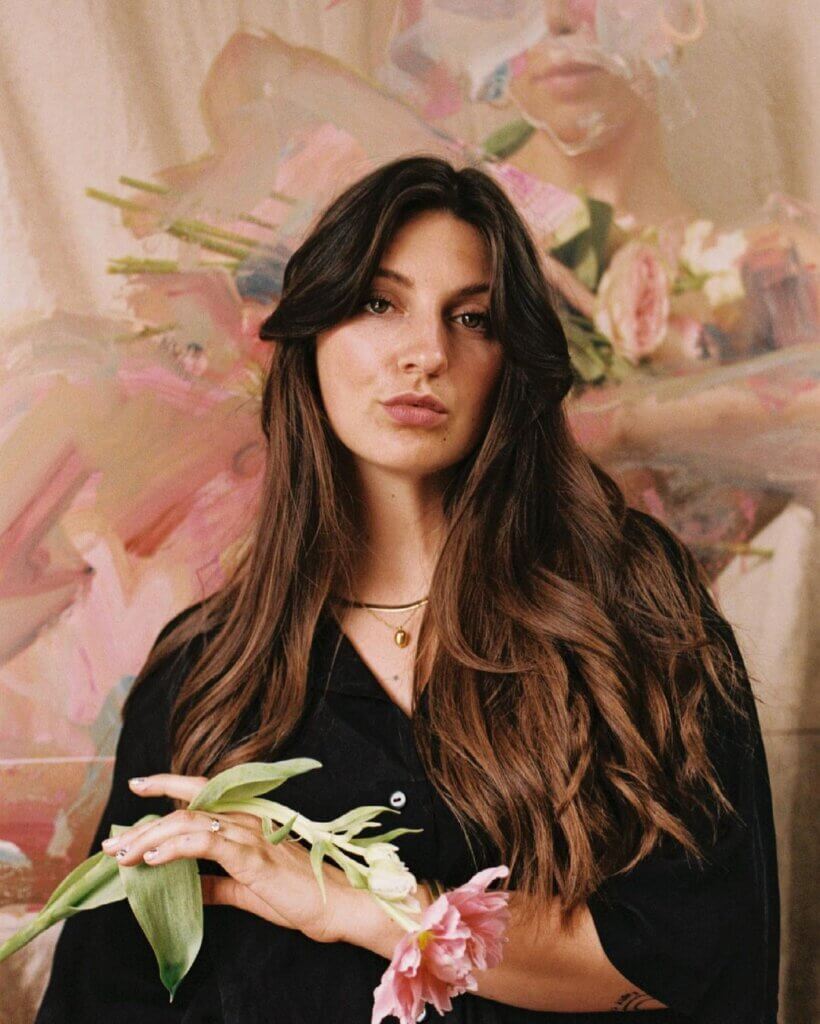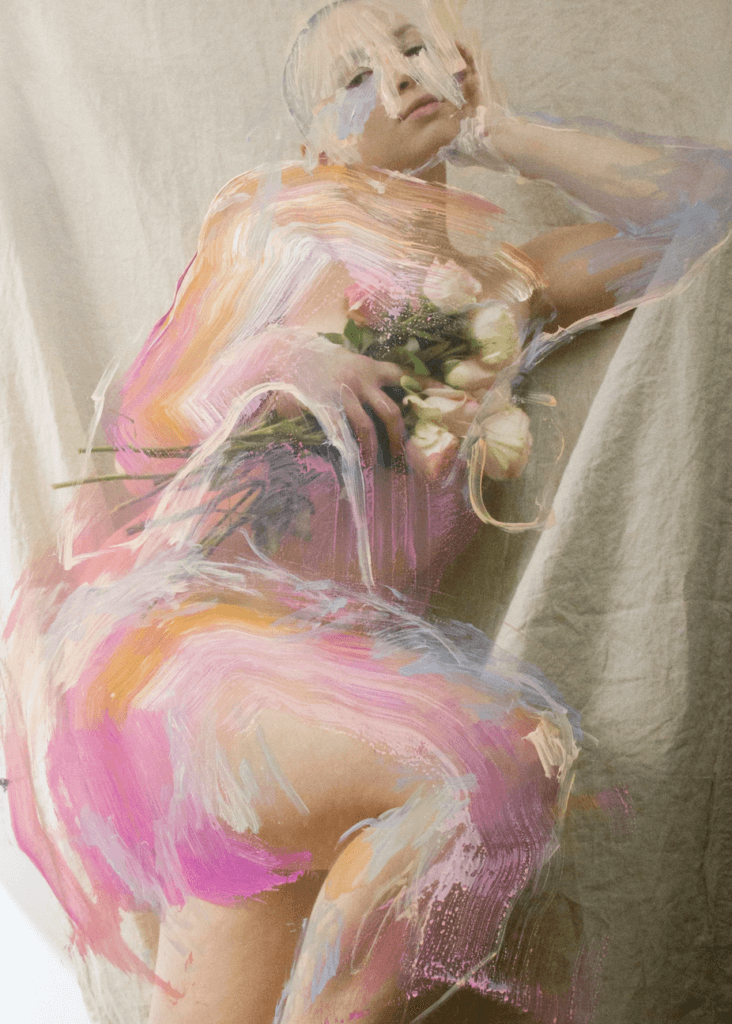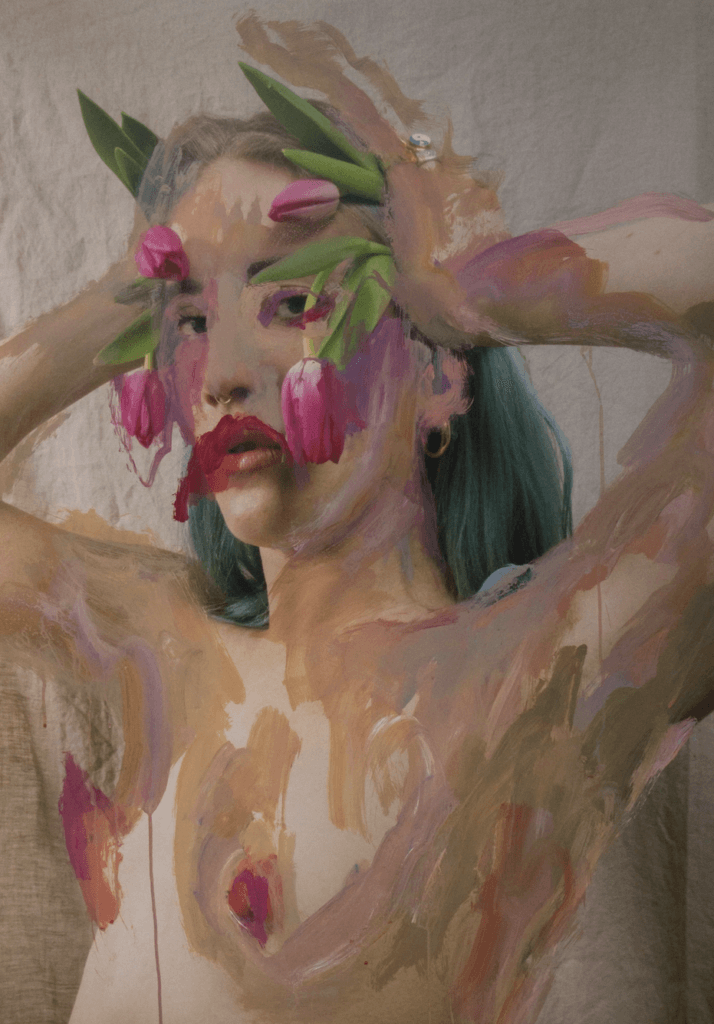We managed to catch up with contemporary artist Jess Cochrane, to speak with her about a current exhibition titled ‘A Woman By Any Other Name.’ That features her latest body of work, a series of portraits inspired by the symbolism of 17th-century portraiture. These new works depict women ornamented with fruits and flora traditionally represented in Renaissance portraiture.
Although I don’t exclusively paint women, it’s fair to say that a lot of my work taps into feminine energy. It’s powerful. I have always worked with what I know; drawing from my experience as a woman and the connections I have with my subjects. The work is a reflection of that.
Jess Cochrane
Cochrane’s work is known for its provocative feminine beauty. In this series, she connects the points between art history, design and advertising: questioning the intent behind classical symbols in
modern society.
Her interrogation of traditional symbols and motifs reclaims the independence for the women she paints. Her statements pieces are bold and striking. In this Q&A, we learn more about the motivation behind the exhibition and more.
Q: Firstly, congratulations on your new exhibition with Rhodes Contemporary, ‘A Woman By Any Other Name’. The work is incredibly moving. How does it feel to be exhibiting IRL again after the pandemic?
Jess Cochrane: Thank you so much! it feels so great to be back in the physical art world. If anything, having a time-slot viewing system for the show has been hugely beneficial as everyone has been able to take in the work in their own time without having to duck and dodge other viewers.
Q: We love to hear any positives that have come from Covid! Tell me a little about this body of work?
Jess Cochrane: I’ve had a lot of time and space to make this body of work due to the pandemic. It started when I took a trip to Amsterdam last year for my birthday and spent some time contemplating the incredible works at the Rijksmuseum. I was fascinated by how so many of the masterful paintings of the 17th century present themselves so calmly, yet have so much symbolism and meaning hidden within the props or subjects
I found myself struck by how many of these symbols were there to serve traditional notions of life and how, when these symbols were placed with women, they acted as a way of telling the viewer whether or not that woman was worthy of praise by men and society. Some of the symbols hidden in such works are incredibly damning. With my constant fascination of how our history is still shaping our current culture, this just seemed like a fun idea to subvert and play with.
Q: What was the inspiration behind the title?
Jess Cochrane: “A Woman By Any Other Name” is a play on Shakespeare’s famous line from Romeo & Juliet. It’s not about what something is called but what it is at heart. I truly believe that at heart, woman are exponentially more than what society has allowed us to acceptably present ourselves as.
Q: Which renaissance works in particular inspired the paintings?
Jess Cochrane: There was no one work in particular that I was referencing. It was more about looking at how these works have shaped the underlying ideologies surrounding femininity and women, collectively. I found the symbols to be oddly relatable to the advertisements that played on the popular ideals of past eras. I think theres a lot of similarities there…
Q: What is the significance of the props you have chosen to shoot your models with?
Jess Cochrane: The strawberries; abundant in shallow seeds, are the ultimate symbol of fertility. I wanted the string of strawberries around the model’s neck to illustrate the weight of fertility and woman’s biological clock. It’s also a nod to the pearl necklaces and elaborate finery from old masters paintings.
The apple traditionally bears the message of sexual desire or sin – think Adam & Eve. Woman is sent to lead man astray; she is enticing and ripe: a forbidden fruit. Since the 15th Century, lilies and roses have been woven into depictions of the Virgin Mary to symbolise her purity and dedication to God.
According to the ancient Persian legend, the tulip was born of the blood of a girl who ventured into the desert in search of her lover. The more you read into the symbolism of flowers the more you start to realise how they are connected to women’s mental anguish.
I can’t help but think about this ancient Persian legend of the tulip as a metaphor for how women have been portrayed and objectified throughout history. Not dissimilar to the way flowers cut from the ground displayed in a vase are there for us to consume, admire and watch slowly wilt. Only to be replaced by a fresher, prettier arrangement. Relatable.
Q: Do you think these symbols have any modern-day equivalents?
Jess Cochrane: As my friend Verity said of the work, “today, we might simplify advertisements by saying that, in order to sell a handbag or perfume, you add a sexy woman. Historically, in order to sell a woman, you simply add an exotic flower, or a lush banquet.”
Q: That’s definitely food for thought. Finally, if there was one message you’d like your audience to take from this work, what would it be?
Jess Cochrane: I just want viewers to take away a sense of refreshment when it comes to viewing women and if the work sparks any questions or conversation, then I’m stoked.
https://www.instagram.com/jesscochrane____/
©2021 Jess Cochrane










